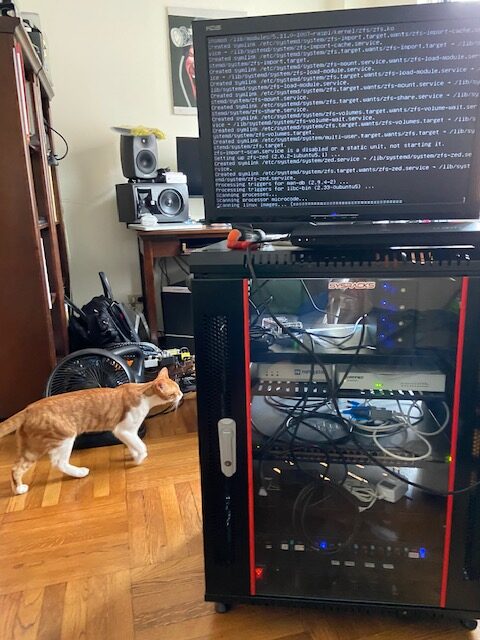
I started my Home Lab In order to get hands on experience with a variety of emerging technologies. It gives me the space to learn, build, break, and fix things in a controlled setting. As the world continuously changes, there is constant research, evaluations, and proof of concepts that must be performed constantly and rapidly on multiple technologies for a solution to determine the best path to resolution.
My Home Lab contains numerous devices: a SuperMicro Server, various Raspberry Pis, pfSense router, a Juniper and MikroTik switching, Fortigate Firewall, PCs, Macs, Linux servers, WiFi APs, a printer servers, and a monitored UPS power backup. I run a variety of VMs, Docker containers, headless Pis, and Samba Shares (across all operating systems).
The centerpiece of the collection is the SuperMicro server – I got it used and upgraded the CPUs to something more efficient with more cores. Through the IPMI, I was able to install TrueNAS Scale, which I currently use as my main OS. From there I can run VMs, set up storage pools, and do anything else I’d need a server to do. It has 12 drive bays, and I have TrueNAS on a SATA-DOM, so it doesn’t take up a bay.

I have numerous Raspberry Pis – and each are for different things. My favorite is the Pi NAS (Network Attached Storage) server – I have a RAID-Z1 (four drives) that can be accessed by any computer on the network via a Samba share. This also gets backed up weekly (cron) to an external drive completely separate from those four, just in case of a catastrophic failure. My next Pi project is going to be replacing my DNS server with PiHole so I can be in more control of the DNS blocking on my network. (I tried PFBlocker numerous times and have run into a variety of weird issues – so I’m going for something else)

I also completely rebuilt my PC. The computer I had was a 2008 Velocity Micro machine and had a lot of trouble keeping, especially during gameplay. I stripped it down to bare metal, and started from scratch. Most importantly, I replaced the motherboard with an AMD B550 Aorus Elite with a Ryzen 5 5600X processor. I also upgraded the power supply, memory, and graphic card. There are 5 slots for hard drives, so I added a server HBA card to get the best throughput from each of the drives to the PCI lanes. I put back in the original CD rom drives, but I also added a hot swap bay in the front for hard drives; add the fans and lights, and it’s basically a brand new machine.
You can see some more of my homelab projects on articles page, such as my GreyLog server or VPN testing (coming soon, if it’s not there already).
Recently I’ve been experimenting with a couple of different VPN tunnels to reach a friend’s LAN. So far we’ve tested OpenVPN and Wireguard (both on pfSense). They work mostly the same, but have some subtle differences – with Wireguard, we were more easily able to implement a /31 network (with only two nodes – our two routers).
